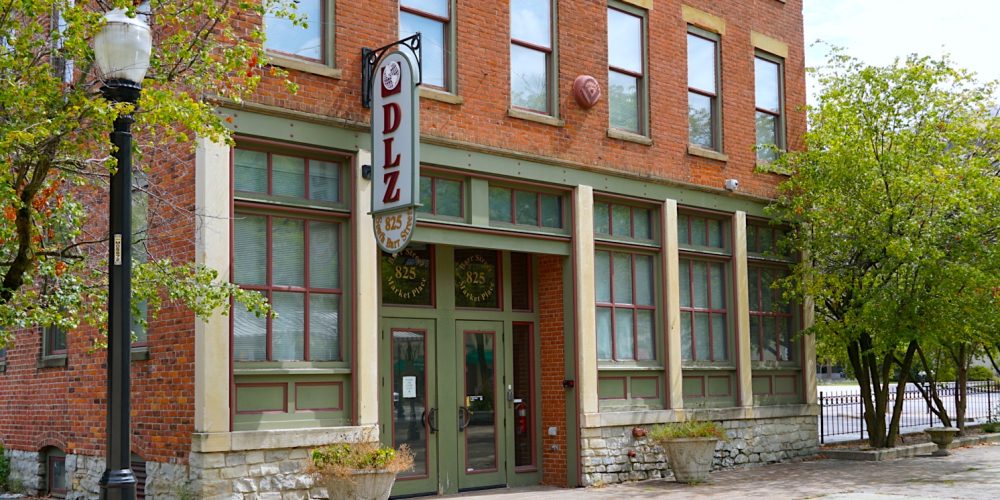DLZ is a different kind of architectural firm—one that hearkens back to the days when businesses did everything in-house. And their history may have a little something to do with that. Thanks to a few mergers, pieces of DLZ date all the way back to 1916—giving them over 100 years in the industry.
Having this long of a portfolio, you can imagine their level of expertise. And while you might not know them by name, you definitely know some of their projects. They’re the minds behind the iconic Martin Luther King Jr. Bridge, the expansive Pufferbelly Trail, and many other city landmarks.
While they’ve been in the game for over a century on a national level, they’ve been in the Downtown Fort Wayne community for an impressive 25 years. Originally, DLZ’s Fort Wayne office was located in the Rosemarie Alley building—an old ivy-clad brick building that used to stand where Mercado, Papi’s Pizza and Urban Hippie are located now. Fort Wayne history buffs and old C-street regulars are certain to know the place.
Nowadays, DLZ resides on Barr Street in another old, beautiful, brick building with a rich history (you might say, they have “a type”). If you’ve gone to a YLNI Farmers Market, you’ve seen their offices overlooking the pavilions of the historic Barr Street Market.
This August marked 10 years at their Barr Street location. To help them celebrate their anniversary, we stopped by to get to know more about their legendary practice.
Here’s the 4-1-1 with DLZ’s Miguel Trevino!
Molly: DLZ has had a Downtown Fort Wayne office for over 25 years, and has owned their current office for ten years this August. So happy birthday! Ten years is impressive! Before we move any further, I have to know: what does DLZ stand for?
Miguel: Our name is a combination of several mergers and acquisitions that have transpired over the course of the company’s history. The very first company was Dodson Lindblom (DL). Then over the course of the company’s lifetime, with the other acquisitions, the Owner (Vikram “Raj” Rajadhyaksha, P.E.) decided to place a “Z” at the end of it to cover all the other companies.
Molly: From what I’ve read, the firm is a minority-owned business enterprise (MBE) that started in 1916. Can you tell us more about the story of its founding?
Miguel: The owner—“Raj”—immigrated to the States from India, so his story is a true American Success Story. He started out as an employee of Dodson Lindblom. The owner at that time was set to retire and close the doors of the company. Raj approached the owner and offered to buy the company. Raj bought Dodson Lindblom and started working primarily for the Army Corps of Engineers and state agencies. DLZ later acquired Cole Associates in South Bend, Indiana, which was the largest and oldest firm DLZ acquired, which gives our firm its 1916 roots.
Molly: What makes DLZ different from other architecture and design firms?
Miguel: We are a full-service firm. So, we offer many disciplines and services that many firms do not have available in-house. Those firms would normally contract with specialty sub-consultants to provide those specialty services. With DLZ, the client can have one contract and one point of contact. Communication, coordination, and quality control are streamlined. Even with many offices across the nation, we operate as one company. Companies with more than one office often allow that office to maintain autonomy with their market and clients. DLZ does not.
DLZ also focuses our work and experience working with local, county, state and federal agencies. That is our niche. We don’t jump markets when the markets get bad. We stay loyal to our government clients.
Molly: Can you name some Fort Wayne projects that DLZ has worked on since 1998?
Miguel: Because DLZ acquired Coles Associates, our project history with the City of Fort Wayne dates all the way back to 1929, when the city built its first treatment plants. Cole Associates was involved with the design services of the treatment plants and many of the brick sewers that are still in use today.
Other recent projects, just to mention a few, are the Martin Luther King Bridge, the Columbia Street Bridge, Goshen Avenue design (we’re currently working on phase two of that project), the roundabout from Sherman Boulevard to Cambridge Boulevard, St. Joe Center Road Design, many trail projects around the city, like the Towpath II & III, Pufferbelly Trail, phases one and two of the New York/Central Rail to Trail, and the Engle Road Trail. We’re on the design team for drop shafts for the City of Fort Wayne tunnel, we’re providing construction observation of the City of Fort Wayne tunnel, and we’ve been working with INDOT to widen I-69 around Fort Wayne.
Molly: What stands out about the Fort Wayne market compared with the other markets DLZ operates in?
Miguel: The growth that has taken place in this city compared to other cities is what sets it apart.
Molly: What project are you personally most proud of and why?
Miguel: All of them. We help communities grow and build their infrastructure, no matter how big or small the project is. I honestly believe we improve the quality of life for each community we work for and for the generations to come.
—
To see more of DLZ’s projects, or to get in touch, visit DLZ.com.
 Molly Conner is a Fort Wayne native and freelance writer. Having lived in Downtown Fort Wayne throughout her twenties, she loves watching her stomping grounds grow. With her love of storytelling and community in tow, she’s eager to tell Downtown Fort Wayne’s story piece-by-piece—exploring the people, spaces, and organizations that make it thrive.
Molly Conner is a Fort Wayne native and freelance writer. Having lived in Downtown Fort Wayne throughout her twenties, she loves watching her stomping grounds grow. With her love of storytelling and community in tow, she’s eager to tell Downtown Fort Wayne’s story piece-by-piece—exploring the people, spaces, and organizations that make it thrive.

